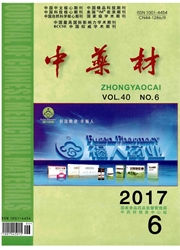

 中文摘要:
中文摘要:
目的:探讨轮作模式与生物有机肥施用对滁菊产量、品质及连作土壤酶活性的影响。方法:以连作9年的滁菊试验田为研究对象,设置滁菊连作模式、常规滁菊小麦轮作模式和滁菊小麦轮作模式配施生物有机肥三个处理,分别测定土壤酶活性、滁菊产量与品质指标。结果:采取菊麦轮作可显著提高滁菊中总黄酮、绿原酸、可溶性糖及游离氨基酸总量,且在配施生物有机肥下表现最优,其含量分别达到42.59 mg/g、2.52mg/g、4.04mg/g、73.33mg/100g。菊麦轮作有利于促进滁菊生长,改善滁菊花序性状,滁菊有效分支增加,花头数显著提高,进而提高单株鲜花数量。在试验条件下,菊麦轮作模式表现出较高的增产效果,与滁菊连作模式相比产量增加最高可达28.21%,产量达400.9kg/667m^2。菊麦轮作模式可显著提高滁菊连作土壤脲酶、酸性磷酸酶、蔗糖酶和蛋白酶活性,降低土壤过氧化氢酶活性。结论:通过采用合理的菊麦轮作和增施生物有机肥,可以有效促进滁菊生长和产量形成,提高滁菊品质,改善土壤肥力状况,有效减轻滁菊连作障碍。
 英文摘要:
英文摘要:
Objective : To investigate the effects of chrysanthemum-wheat rotation system and biological manure on continuous crop- ping soil enzyme activities and quality and yield of Chrysanthemum morifolium. Methods:Field experiments were conducted at the re- search base of Anhui Jutai Chuju Chrysanthemum morifolium Herbal Technology Co. , Ltd. , in Shiji Town, Nanqiao Country, Anhui Prov- ince. Samples were collected from treatments under chrysanthemum-wheat rotation system receiving bio-organic manure application of 200 kg/667 m2 , conventional chrysanthemum-wheat rotation system and chrysanthemum continuous cropping system. Results : Chrysan- themum-wheat rotation system and biological manure obviously influenced the quality and yield of Chrysanthemum morifoIium and con- tinuous cropping soil enzyme activities. Compared with chrysanthemum continuous cropping system, total flavonoids, chlorogenic acid, soluble sugar and free amino acid contents, quantitative of ray floret, inflorescence diameter, diameter of tubular floret, number of branch, number of flower and yield of Chrysanthemum morifolium and the activities of urease, acid phosphatase, invertase and protease in soil were increased to 42. 59 mg/g, 2. 52 mg/g, 4. 04 mg/g, 73.33 mg/100 g, 179. 56,5.57 cm, 1.43 cm, 36. 10,330. 00 and 400. 09 kg/667 m^2 , respectively, while hydrogen peroxidase of soil under chrysanthemum-wheat rotation system was decreased. Conclusion : Bio-organic manure application of 200 kg/667 m^2 is benefit to soil environment establishment of chrysanthemum- wheat rotation system and enhancement of quality and yield of Chrysanthemum morifolium while reducing the obstacles of continuous cropping.
 同期刊论文项目
同期刊论文项目
 同项目期刊论文
同项目期刊论文
 期刊信息
期刊信息
